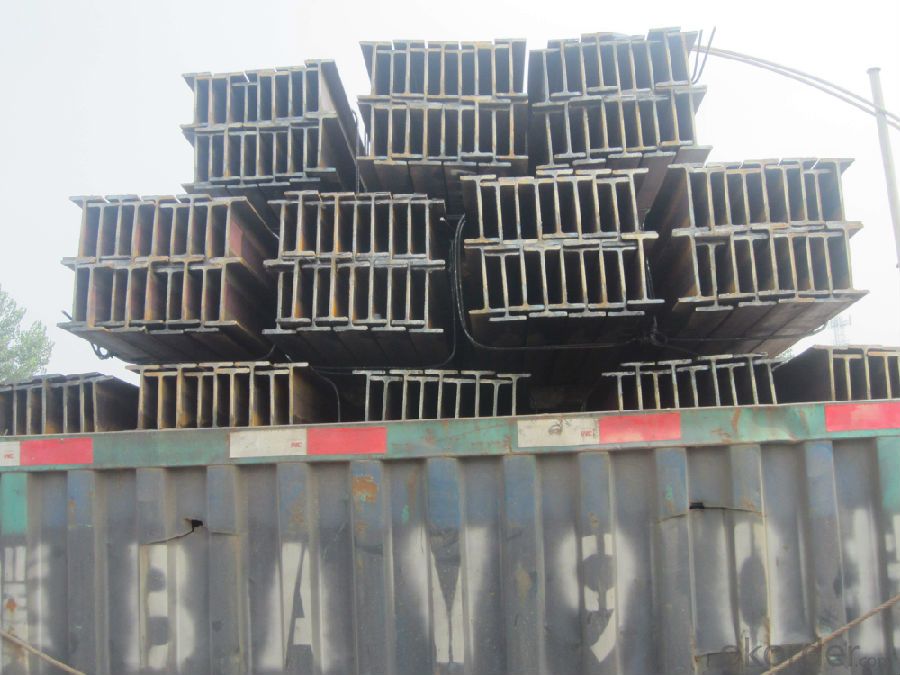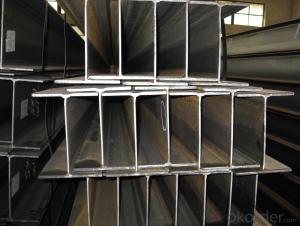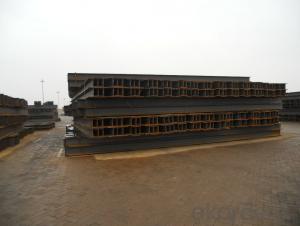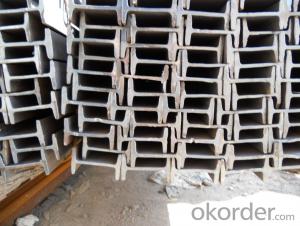H Beam Hot Rolled with Good Quality and Competitive Prices for Sale
- Loading Port:
- Tianjin
- Payment Terms:
- TT OR LC
- Min Order Qty:
- 25 m.t.
- Supply Capability:
- 20000 m.t./month
OKorder Service Pledge
OKorder Financial Service
You Might Also Like
Item specifice
Product Description:
OKorder is offering H Beam Hot Rolled with Good Quality and Competitive Prices for Sale at great prices with worldwide shipping. Our supplier is a world-class manufacturer of steel, with our products utilized the world over. OKorder annually supplies products to European, North American and Asian markets. We provide quotations within 24 hours of receiving an inquiry and guarantee competitive prices.
Product Applications:
H Beam Hot Rolled with Good Quality and Competitive Prices for Sale are ideal for structural applications and are widely used in the construction of buildings and bridges, and the manufacturing, petrochemical, and transportation industries.
Packaging & Delivery:
Packaging Detail: products are packed in bundle and then shipped by container or bulk vessel, deformed bar is usually naked strapping delivery, when storing, please pay attention to moisture proof. The performance of rust will produce adverse effect.
Each bundle weight: 2-3MT, or as required
Payment term: TT or L/C
Delivery Detail: within 45 days after received advanced payment or LC.
Label: to be specified by customer, generally, each bundle has 1-2 labels
Trade terms: FOB, CFR, CIF
FAQ:
Q1: How do we guarantee the quality of our products?
A1: We have established an advanced quality management system which conducts strict quality tests at every step, from raw materials to the final product. At the same time, we provide extensive follow-up service assurances as required.
Q2: Why buy Materials & Equipment from OKorder.com?
A2: All products offered byOKorder.com are carefully selected from China's most reliable manufacturing enterprises. Through its ISO certifications, OKorder.com adheres to the highest standards and a commitment to supply chain safety and customer satisfaction.
Q3: How soon can we receive the product after purchase?
A3: Within three days of placing an order, we will begin production. The specific shipping date is dependent upon international and government factors, but is typically 7 to 10 workdays.
Images:


- Q:What are the common sizes of steel H-beams?
- The common sizes of steel H-beams vary depending on the specific needs and requirements of a project. However, there are several standard sizes that are commonly used in construction and engineering applications. Some of the most common sizes include: - W6x9: This size refers to a wide flange beam with a height of 6 inches and a weight per foot of 9 pounds. It is often used in residential construction or smaller structural applications. - W10x33: Another popular size, this wide flange beam has a height of 10 inches and weighs 33 pounds per foot. It is commonly used in commercial construction and larger structural projects. - W12x65: This wide flange beam has a height of 12 inches and weighs 65 pounds per foot. It is often used in heavy-duty construction projects or for supporting larger loads. - W18x76: With a height of 18 inches and a weight per foot of 76 pounds, this wide flange beam is commonly used in industrial applications or for supporting extremely heavy loads. - W36x135: This is one of the largest commonly available sizes of wide flange beams, with a height of 36 inches and weighing 135 pounds per foot. It is typically used in the construction of large-scale structures such as bridges or high-rise buildings. These are just a few examples of the common sizes of steel H-beams. It is important to consult with a structural engineer or reference specific industry standards to determine the appropriate size for a particular project, as the size requirements can vary depending on factors such as load capacity, span length, and structural design.
- Q:How do steel H-beams perform in dynamic loads?
- Steel H-beams are highly effective in withstanding dynamic loads due to their structural characteristics. The H-shaped cross-section of these beams provides excellent strength and rigidity, making them ideal for applications where dynamic forces are a concern. When subjected to dynamic loads, such as impact or vibrations, steel H-beams exhibit a high resistance to deformation and fatigue failure. Their shape allows for even distribution of the applied loads, which minimizes stress concentrations and prevents localized failure points. This makes them highly reliable and durable under dynamic conditions. Moreover, steel is known for its high strength-to-weight ratio, which means that H-beams can withstand significant dynamic loads while maintaining a relatively low weight. This not only simplifies the structural design but also reduces material and transportation costs. Steel H-beams also possess excellent elasticity, meaning that they can absorb and dissipate energy from dynamic loads, minimizing potential damage or deformation to the structure. This elasticity helps in reducing the amplitude of vibrations and prevents the propagation of stress waves throughout the beam. In summary, steel H-beams are well-suited for dynamic loads due to their structural integrity, high strength-to-weight ratio, and elasticity. They can effectively resist deformation, fatigue, and impact caused by dynamic loads while maintaining their structural integrity and durability.
- Q:Are steel H-beams resistant to extreme temperatures?
- Yes, steel H-beams are generally resistant to extreme temperatures. Steel is known for its excellent thermal conductivity and high melting point, which makes it highly resistant to heat. H-beams, specifically, are designed to support heavy loads and maintain their structural integrity even in challenging conditions. They are commonly used in construction projects where extreme temperatures, such as those experienced in industrial settings or in fire situations, may be present. However, it is important to note that prolonged exposure to extremely high temperatures can affect the strength and structural integrity of steel, so proper insulation and fireproofing measures should be considered in such cases.
- Q:Can steel H-beams be used in mezzanine floor construction?
- Indeed, it is possible to employ steel H-beams in the construction of mezzanine floors. These H-beams, alternatively referred to as I-beams or universal beams, are frequently utilized in the field of construction owing to their impressive strength and ability to bear heavy loads. Mezzanine floors, which serve as intermediate levels between a building's primary floors, often necessitate the use of steel beams to support the added weight and ensure structural stability. Opting for steel H-beams in mezzanine floor construction is a highly recommended choice due to their capacity to endure substantial loads and provide enduring durability.
- Q:How do steel H-beams perform in noise reduction applications?
- Noise reduction applications typically do not involve the use of Steel H-beams. Although these beams are commonly utilized in construction and structural projects due to their strength and load-bearing capabilities, they lack a specific design for noise reduction purposes. In terms of reducing noise, there are other materials and techniques that are more effective. For instance, acoustic panels or insulation materials are frequently employed to absorb or block sound waves. These materials possess specific acoustic properties that minimize sound transmission. Conversely, Steel H-beams are primarily employed to provide structural support and stability in buildings and other structures. They are not recognized for their capacity to absorb or block sound. In fact, steel is a dense and rigid material that can actually transmit and amplify sound vibrations rather than reducing them. Hence, if noise reduction is of utmost importance, it is advisable to explore alternative options that are specifically designed for this purpose. Seeking the guidance of acoustic engineers or professionals specializing in noise control can offer more suitable solutions based on the specific requirements and limitations of the project.
- Q:How do steel H-beams perform in areas with high wind loads?
- Steel H-beams perform very well in areas with high wind loads. The H-shape design of these beams provides superior strength and stability, making them highly resistant to lateral forces caused by strong winds. The structural integrity of steel H-beams allows them to distribute the wind load evenly throughout the entire beam, minimizing the risk of failure or deformation. Additionally, steel is a durable and flexible material, which further enhances its performance in high wind areas. The high tensile strength of steel enables it to withstand the pressure exerted by strong winds, offering excellent resistance against bending or buckling. Overall, steel H-beams are an ideal choice for construction in areas with high wind loads, providing reliable and long-lasting support to structures in such conditions.
- Q:Can steel H-beams be used in railway infrastructure?
- Yes, steel H-beams can be used in railway infrastructure. They are commonly used for various applications such as constructing railway bridges, supporting railway tracks, and creating structural elements in railway stations and terminals. Steel H-beams offer significant strength and durability, making them suitable for withstanding heavy loads and providing stability in railway infrastructure.
- Q:How are steel H-beams specified in construction drawings?
- Steel H-beams are specified in construction drawings by providing detailed information about their dimensions, material properties, and other relevant specifications. The specifications typically include the following: 1. Size: The size of the H-beam is specified by its depth, width, and weight per unit length. The depth refers to the vertical distance between the top and bottom flanges, while the width refers to the horizontal distance across the top and bottom flanges. The weight per unit length indicates the amount of steel used in the H-beam. 2. Material: The type of steel material used for the H-beam is specified, along with its grade and any additional requirements. Commonly used materials include carbon steel, high-strength low-alloy steel, and stainless steel, among others. 3. Profile: The profile of the H-beam is also specified, indicating the shape of the flanges and the web. This can be standard or custom profiles, depending on the specific requirements of the project. 4. Tolerances: Tolerances for dimensions, straightness, and other relevant parameters are specified to ensure that the H-beams meet the required standards and can be fabricated accurately. 5. Connections: The type of connections to be used with the H-beams, such as bolted or welded connections, is often specified in the construction drawings. This helps in determining the appropriate design and fabrication details for the connections. 6. Finishes: If any specific finishes or coatings are required for the H-beams, such as galvanizing or painting, they are specified in the drawings to ensure proper protection and aesthetics. 7. Marking: Each H-beam is typically marked with a unique identification number or symbol. The marking details are specified in the construction drawings to ensure proper traceability and identification during fabrication and installation. By providing these specifications in the construction drawings, architects, engineers, and fabricators can ensure that the steel H-beams used in the construction project meet the design requirements, regulatory standards, and quality expectations.
- Q:Can steel H-beams be used for stadium construction?
- Yes, steel H-beams can be used for stadium construction. Steel H-beams are commonly used in structural engineering for their strength and load-bearing capabilities. They provide excellent support for large and heavy structures like stadiums, ensuring stability and safety.
- Q:How do steel H-beams compare to timber beams?
- Steel H-beams are generally stronger, more durable, and have a higher load-bearing capacity compared to timber beams. Additionally, steel beams are fire-resistant and less susceptible to rot, pests, and warping, making them a preferred choice for heavy construction and structural applications. However, timber beams are often more cost-effective, easier to work with, and can provide a more aesthetic appeal in certain architectural designs. Ultimately, the choice between steel H-beams and timber beams depends on the specific needs, budget, and design preferences of the project.
1. Manufacturer Overview |
|
|---|---|
| Location | |
| Year Established | |
| Annual Output Value | |
| Main Markets | |
| Company Certifications | |
2. Manufacturer Certificates |
|
|---|---|
| a) Certification Name | |
| Range | |
| Reference | |
| Validity Period | |
3. Manufacturer Capability |
|
|---|---|
| a)Trade Capacity | |
| Nearest Port | |
| Export Percentage | |
| No.of Employees in Trade Department | |
| Language Spoken: | |
| b)Factory Information | |
| Factory Size: | |
| No. of Production Lines | |
| Contract Manufacturing | |
| Product Price Range | |
Send your message to us
H Beam Hot Rolled with Good Quality and Competitive Prices for Sale
- Loading Port:
- Tianjin
- Payment Terms:
- TT OR LC
- Min Order Qty:
- 25 m.t.
- Supply Capability:
- 20000 m.t./month
OKorder Service Pledge
OKorder Financial Service
Similar products
New products
Hot products
Hot Searches
Related keywords


























